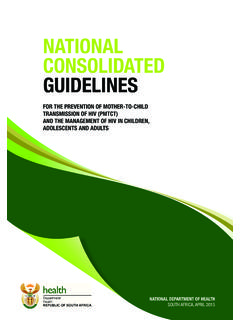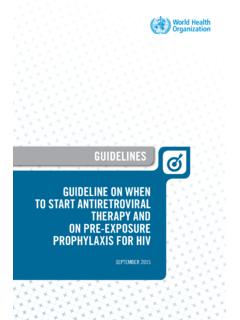Transcription of How to fix the district health care system: What …
1 How to fix the district health care system: What district Managers told us in 2013 about the obstacles and challenges they face Dr GustaafWolvaardt MBChB, (Int), FCP(SA) AMP(MBS), PGCHE Managing Director FPD Departure Points Role of the district in the health care system The district health System (DHS) is the organisational entity around and through which the provision of healthcare delivery should be organised as mandated by the national health Act (61 of 2003).1 The World health Organization (WHO) defines a DHS based on PHC as .. a more or less self-contained segment of the national health System. It comprises first and foremost a well-defined population, living within a clearly delineated administrative and geographical area, whether urban or rural. It includes all institutions and individuals providing health care in the district , whether governmental, social security, non-governmental, private, or traditional. A district health System therefore consists of a large variety of inter-related elementsthat contribute to health in homes, schools, work places, and communities, through the health and other related sectors.
2 It includes self-care and all health care workers and facilities, up to and including the hospital at the first referral level, and the appropriate laboratory, other diagnostic, and logistic support design Study design Data was collection methods. Desktop review of literature individual semi-structured interviews were conducted with 9 district managers . quantitative data collected using a structured questionnaire completed by 233 operational and district managers interviews with representatives of the PEPFAR DMTs and analysis of baseline assessment done by some PEPFAR partners. Study provides a snap shot of: 25 districts , both urban and rural covering all provinces Results Overarching issues A roadmap for the reform of the South African health system Development Bank of South Africa (DBSA) 2008 Suggests that the reason for South Africa s deteriorating health outcomes lies in flaws in institutional design, and stresses the need for institutional design to be a central theme for health system It recommends that restructuring health districts to improve performance is an essential prerequisite for achieving any improvement to the public health goals.
3 This report further cites problems around : governance frameworks, specifically the lack of decentralisation of authority to district or hospital management levelthat thus lack the mandate to carry out their functions The report concludes that a dysfunctional district system will never be able to effectively carry out programmes assigned to it, and consequently represents an obstacle to improvements in the achievement of key health goals. So have these overarching problems been fixed since 2008? PLANNING STEP 1 Develop a strategy with clear goals and objectives customized to local realities ORGANISING STEP 2 Develop operational plans listing the actions required to implement strategic goals and objectives including what? where? when? and who? How do you know it s done ( indicator and target) Develop a zero based budget linked to the operational plan STAFFING STEP 3 Workforce planning Selection Appointment Briefing Training Mentoring to answer the "who" question in the operational plan DIRECTING STEP 4 Coordination Progress review based on indicators Problem solving Updating of operational plan CONTROL STEP 5 Evaluation Reward Report on lessons learned Recommendations POLICY MANDATES DEPARTURE POINT OF MANAGEMENT PROCESS Institutional design blockages 1.
4 district management has no influence over policy directives. 2. Strategy is defined at national / Provincial level. 3. district management has limited influence over allocated budget. 4. district does not control workforce planning and appointment of staf. 5 & 6. No clear system whereby lessons learned at district level is used to influence policy or strategy. Rest of the results are reported according to the WHO HS building blocks Major points service delivery: Lack of strategic planning skills Vacancies in key positions Short term focus in planning Lack of provincial direction to allow prioritisation around service delivery Limited coordination of public, private and civil society efforts in district Major points health workforce: What we found Lack of delegation of most HR related authority to DMT Lack of reliable up to date HR information Clinical and managerial staff shortages Limited attention to retention issues Dissatisfied clinical staff in facilities Lack of HR skills amongst line managers What health care workers told AHP (6 Provinces) health Worker SatisfactionMajor points information.
5 Inadequate data ownership and accountability,for quality, by line managers , Lack of data driven decision making, Lack of sufficient resources human and IT to capture and process data , Poor data quality,Major points information: Lack of transition of data into more user friendly strategic information, Lack of research to capture grass roots points medical products: A key management position that of the district pharmacists is often vacant, Outdated and often manual stock controls systems, Some provincial depots, facility based pharmacies and PHC facilities are not accredited/registered with SAPC as required by legislation, Shortage or pharmacists and pharmacy assistants, Shortage of training facilities for pharmacy points health financing: Lack of district ownership of budget allocation, Insufficient budget allocations to implement DHPs, Limited mechanisms to secure additional funding, Lack of ownership or accountability at facility level management for over expenditure, Lack of financial management skills, Vacant financial management positions, Ineffective financial management points leadership & governance: Lack of managerial qualifications and competency , Acting managersoften only play a caretaker role, Some vacancies in key managerialpositions, Neglected governance structures, Detrimental impact of regular changes at provincial political leadership and senior management Overarching The institutional design problems identified in the DBSA 2008 report6still exist and issues around delegation of authority and management autonomy need to be resolved.
6 Districts should be granted the authority to implement DHPs,as only under such a scenario will it be possible to hold DMTs accountable for service delivery. Service delivery Planning Need for longer-term strategic planning at district level supported by one-year work plans. It is crucial that DMTs develop strategic planning skills have access to all relevantnational and provincial strategic documents, Need to planinitiatives around using all resource (government private and NGO sector) Need to involve all sector partners in planning Service delivery People Keymanagerial and clinical positions must be filled with competent and committed people whose performance is monitored with appropriate rewards and sanctions. All employees in the district health system should be acquainted with the contents of the workforce Workforce planning should be a priority activity for district management supported by reliable strategic HR information.
7 Ratiosfor the number of managerial and administrative positions in relation to service delivery positions should be established. Recruitment times should be shortened and the issuing of employment contracts should take place within a reasonable time (30 days) through devolving authority for issuing such workforce Line managers HR skills should be dramatically improved Performance management systems should hold managers accountable on HR indicators such as staff satisfaction, staff turnover and productivity. Comprehensive induction programmes that address clinical, social, cultural and logistical orientation of newly recruited health workers should be developed. Professional and personal isolation of managers and clinical staff in rural areas should be addressed through Continuing Professional Development (CPD) sessions that convene health workers and facilitate action learning sets for managers. Information and research To ensure data ownership, three immediate interventions are recommended: orientating all levels of managers on their roles and responsibilities in accordance with the DHMIS policy; updating performance agreements to include data verification and data use; and requiring all managers (not only the information managers) to use data from the South African government s health Information Systems (HIS) for their monthly reporting against targets at programme and/or facility level.
8 Districts should allocate a larger operational budget for equipment and staff especially junior technicians . Information and research Districts should explore point-of-care reporting using simple phone-based applications to capture data and process information. The use of dashboards, barometers and other data interpretation toolsshould be implemented to assist managers in translating data into information for decision-making A research culture should be developed at district level to ensure that grassroots learning is captured and disseminated. Medical Products and technology The DMT, in co-operation with the district pharmacist, should develop annual pharmaceutical budgets and item forecasts for submission to the PDoH. district pharmacist positions should be filledand these pharmacists should play an active role in preventing overstock and expiry of items at all facilities by re-distributing items within the district .
9 The provisioning and standardisation of computerised, user-friendly stock control and dispensing systems in hospitals and community healthcare centres is essential. The DMT should ensure compliance of pharmacies and PHC facilities with SAPC regulations, and should settle annual registration fees for the facilities and pharmacy staff. All pharmacies must be accredited for training of pharmacy staff as required by the care financing Zero-based budgetingshould be encouraged, preferably using an indicative amount as a baseline provided by the Provincial Treasury so that DMTs have an understanding of the expected funding. Budgeting should be done according to district -specific priorities, with sufficient authority devolved to the DMTs to allow them to adjust district objectives based on actual funds received. There is a need to bail out districts caught in a revolving deduction of the previous year s overspend from the current year s budget.
10 Accountability for expenditure and income (in the case of user fees) should be devolved to the lowest possible line manager, such that clinic managers budget ownership, with accountability by line managers, is built into their performance plans. health care financing If national priority programmesare introduced during a budget year, such programmes should be fully costed to district level and implementation should be subject to additional funding being provided. Standardised financial management tools and procedures should be developed allowing line managers to review their income and expenditure on a monthly basis, Leadership and Governance Ensuring managerial competence should be a high priority for all DMTs and all senior managers should acquire a management qualification. Where required, mentorship programmes should be instigated. Competency should be ensured through effective performance management using an objective outcomes-based system such as Balanced Score and Governance Acting managers should have the required authorityto fulfil the requirements of the post.















